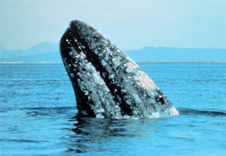 The California coast is best known for its migrating giants, the gray whales and the Northern Pacific humpback whales. What a thrill to be out on the ocean enjoying a day’s sail and to witness one of these great ocean travelers rise up from the depths or to suddenly see the flash of the enormous flukes.
The California coast is best known for its migrating giants, the gray whales and the Northern Pacific humpback whales. What a thrill to be out on the ocean enjoying a day’s sail and to witness one of these great ocean travelers rise up from the depths or to suddenly see the flash of the enormous flukes.
Found only on the Pacific Coast, gray whales are most well known for their twice-yearly migration between Alaskan waters and Baja California. Beginning in December, pregnant females make the journey south traveling 6,000 miles to the calving grounds at the lagoons of Baja California. Mature males, non-pregnant females and juveniles follow through early February. Then beginning in February they head back to Alaska with their newborn babies in tow.
Therefore, gray whales can be seen off the coast starting in Dec, and continuing, until sometimes as late as June.
They are medium sized and reach about 45 feet long. As with other baleen whales females are slightly larger than males. Their coloring is slate gray with white and they are covered with barnacles and barnacle scars giving them a blotchy appearance. They have two blowholes, and no dorsal fin. A normal dive takes them to 120 feet and it’s estimated they can go as deep as 500 feet and stay down for as long as 15 minutes.
Gray whales and humpback whales are baleen whales. That means they have no teeth. Instead their mouths are lined with rows of bony plates through which they strain seawater, feeding on tiny plankton.
Just as the gray whales make it back to Alaskan waters, humpback whales are leaving on their journey to tropical seas. On their way they spend time feeding in the nutrient-rich waters off the Central Coast From June through September.
Humpback whales are best known for their vocal repertoire. They sing the song of the sea, an array of squeaks, groans, moans and wails.
Early morning is best for whale watching. The seas are calm and the wind hasn’t come up yet. If it’s overcast you’ll be able to see farther since this will reduce glare.
Success at whale spotting is better if you are prepared. Binoculars are a must. You will probably want a few other things too, perhaps a camera, warm clothes, maybe a little lunch, and definitely patience.
Watch for telltale spouts. When a gray whale blows the spray reaches up to 15 feet. On a calm day a keen eye should spot this. If you are really lucky you might catch a whale breaching. This behavior is spectacular to see. More than three-quarters of the whale’s body shoots straight up out of the water, then pivots and the great animal lands on its back with a splash.
Whale watching is fun and you can choose two ways to do this – take a boat cruise or go to areas where you can look out to sea unobstructed. If a boat cruise is your choice you might want to bring along rain gear and seasickness medication.
Virg’s Landing in Morro Bay offers whale watching trips during the gray whale migration season and can be reached (805) 772-1222.
— Ruth Ann Angus










